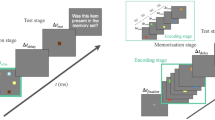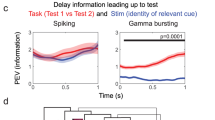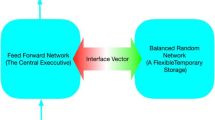Abstract
Working memory (WM) is limited in its temporal length and capacity. Classic conceptions of WM capacity assume the system possesses a finite number of slots, but recent evidence suggests WM may be a continuous resource. Resource models typically assume there is no hard upper bound on the number of items that can be stored, but WM fidelity decreases with the number of items. We analyze a neural field model of multi-item WM that associates each item with the location of a bump in a finite spatial domain, considering items that span a one-dimensional continuous feature space. Our analysis relates the neural architecture of the network to accumulated errors and capacity limitations arising during the delay period of a multi-item WM task. Networks with stronger synapses support wider bumps that interact more, whereas networks with weaker synapses support narrower bumps that are more susceptible to noise perturbations. There is an optimal synaptic strength that both limits bump interaction events and the effects of noise perturbations. This optimum shifts to weaker synapses as the number of items stored in the network is increased. Our model not only provides a circuit-based explanation for WM capacity, but also speaks to how capacity relates to the arrangement of stored items in a feature space.












Similar content being viewed by others
References
Almeida, R., Barbosa, J., Compte, A. (2015). Neural circuit basis of visuo-spatial working memory precision: a computational and behavioral study. Journal of Neurophysiology, 114(3), 1806–1818.
Amari, S. (1977). Dynamics of pattern formation in lateral-inhibition type neural fields. Biological Cybernetics, 27(2), 77–87.
Amari, S. (2014). Heaviside world: excitation and self-organization of neural fields. In Neural fields (pp. 97–118). Springer.
Avitabile, D., Desroches, M., Knobloch, E. (2017). Spatiotemporal canards in neural field equations. Physical Review E, 95(4), 042,205.
Barak, O., & Tsodyks, M. (2014). Working models of working memory. Current Opinion in Neurobiology, 25, 20–24.
Bays, P.M. (2014). Noise in neural populations accounts for errors in working memory. Journal of Neuroscience, 34(10), 3632–3645.
Bays, P.M. (2015). Spikes not slots: noise in neural populations limits working memory. Trends in Cognitive Sciences, 19(8), 431–438.
Bays, P.M., & Husain, M. (2008). Dynamic shifts of limited working memory resources in human vision. Science, 321(5890), 851–854.
Bays, P.M., Catalao, R.F., Husain, M. (2009). The precision of visual working memory is set by allocation of a shared resource. Journal of Vision, 9(10), 7–7.
Bressloff, P.C. (2005). Weakly interacting pulses in synaptically coupled neural media. SIAM Journal on Applied Mathematics, 66(1), 57–81.
Bressloff, P.C. (2009). Stochastic neural field theory and the system-size expansion. SIAM Journal on Applied Mathematics, 70(5), 1488–1521.
Bressloff, P.C. (2012). Spatiotemporal dynamics of continuum neural fields. Journal of Physics A: Mathematical and Theoretical, 45(3), 33,001–33,109.
Bressloff, P.C., & Kilpatrick, Z.P. (2015). Nonlinear langevin equations for wandering patterns in stochastic neural fields. SIAM Journal on Applied Dynamical Systems, 14(1), 305–334.
Bressloff, P.C., & Webber, M.A. (2012). Front propagation in stochastic neural fields. SIAM Journal on Applied Dynamical Systems, 11(2), 708–740.
Burak, Y., & Fiete, I.R. (2012). Fundamental limits on persistent activity in networks of noisy neurons. Proceedings of the National Academy of Sciences, 109(43), 17,645–17,650.
Buschman, T.J., Siegel, M., Roy, J.E., Miller, E.K. (2011). Neural substrates of cognitive capacity limitations. Proceedings of the National Academy of Sciences, 108(27), 11,252–11,255.
Carroll, S., Josic, K., Kilpatrick, Z. (2014). Encoding certainty in bump attractors. Journal of Computational Neuroscience, 37(1), 29–48.
Compte, A., Brunel, N., Goldman-Rakic, P.S., Wang, X.J. (2000). Synaptic mechanisms and network dynamics underlying spatial working memory in a cortical network model. Cerebral Cortex, 10(9), 910–923.
Constantinidis, C., & Klingberg, T. (2016). The neuroscience of working memory capacity and training. Nature Reviews Neuroscience, 17(7), 438–449.
Coombes, S., & Laing, C. (2011). Pulsating fronts in periodically modulated neural field models. Physical Review E, 83(1), 011,912.
Coombes, S., & Owen, M.R. (2005). Bumps, breathers, and waves in a neural network with spike frequency adaptation. Physical Review Letters, 94(14), 148,102.
Coombes, S., & Schmidt, H. (2010). Neural fields with sigmoidal firing rates: approximate solutions. Discrete and Continuous Dynamical Systems Series 28, 1369–1379.
Coombes, S., Schmidt, H., Bojak, I. (2012). Interface dynamics in planar neural field models. The Journal of Mathematical Neuroscience, 2(1), 9.
Cowan, N. (2010). The magical mystery four: how is working memory capacity limited, and why? Current Directions in Psychological Science, 19(1), 51–57.
Edin, F., Klingberg, T., Johansson, P., McNab, F., Tegnér, J., Compte, A. (2009). Mechanism for top-down control of working memory capacity. Proceedings of the National Academy of Sciences, 106(16), 6802–6807.
Ermentrout, B. (1998). Neural networks as spatio-temporal pattern-forming systems. Reports on Progress in Physics, 61(4), 353.
Folias, S., & Ermentrout, G. (2011). New patterns of activity in a pair of interacting excitatory-inhibitory neural fields. Physical Review Letters, 107(22), 228,103.
Fougnie, D., Suchow, J.W., Alvarez, G.A. (2012). Variability in the quality of visual working memory. Nature Communications, 3, 1229.
Funahashi, S., Bruce, C.J., Goldman-Rakic, P.S. (1989). Mnemonic coding of visual space in the monkey9s dorsolateral prefrontal cortex. Journal of Neurophysiology, 61(2), 331–349.
Gardiner, C. (2009). Handbook of stochastic methods, Vol. 4, Springer, Berlin.
Gazzaley, A., & Nobre, A.C. (2012). Top-down modulation: bridging selective attention and working memory. Trends in Cognitive Sciences, 16(2), 129–135.
Gökçe, A., Avitabile, D., Coombes, S. (2017). The dynamics of neural fields on bounded domains: an interface approach for dirichlet boundary conditions. Journal of Mathematical Neuroscience, 7(1), 1–12.
Goldman-Rakic, P.S. (1995). Cellular basis of working memory. Neuron, 14(3), 477–485.
Gorgoraptis, N., Catalao, R.F., Bays, P.M., Husain, M. (2011). Dynamic updating of working memory resources for visual objects. Journal of Neuroscience, 31(23), 8502–8511.
Guo, Y., & Chow, C.C. (2005). Existence and stability of standing pulses in neural networks: II. Stability. SIAM Journal on Applied Dynamical Systems, 4(2), 249–281.
Ikkai, A., & Curtis, C.E. (2011). Common neural mechanisms supporting spatial working memory, attention and motor intention. Neuropsychologia, 49(6), 1428–1434.
Keshvari, S., Van den Berg, R., Ma, W.J. (2013). No evidence for an item limit in change detection. PLoS Computational Biology, 9(2), e1002,927.
Kilpatrick, Z.P. (2013). Interareal coupling reduces encoding variability in multi-area models of spatial working memory. Frontiers in Computational Neuroscience, 7(82), 1–14.
Kilpatrick, Z.P. (2016). Ghosts of bump attractors in stochastic neural fields: Bottlenecks and extinction. Discrete Contin Dyn Syst Ser B, 21, 2211–2231.
Kilpatrick, Z.P. (2017). Synaptic mechanisms of interference in working memory. bioRxiv 149435.
Kilpatrick, Z.P., & Ermentrout, B. (2013). Wandering bumps in stochastic neural fields. SIAM Journal on Applied Dynamical Systems, 12(1), 61–94.
Kilpatrick, Z.P., Ermentrout, B., Doiron, B. (2013). Optimizing working memory with heterogeneity of recurrent cortical excitation. The Journal of Neuroscience, 33(48), 18,999–19,011.
Laing, C.R., & Troy, W.C. (2003a). Pde methods for nonlocal models. SIAM Journal on Applied Dynamical Systems, 2(3), 487–516.
Laing, C.R., & Troy, W.C. (2003b). Two-bump solutions of amari-type models of neuronal pattern formation. Physica D: Nonlinear Phenomena, 178(3), 190–218.
Laing, C.R., Troy, W.C., Gutkin, B., Ermentrout, G.B. (2002). Multiple bumps in a neuronal model of working memory. SIAM Journal on Applied Mathematics, 63(1), 62–97.
Lara, A.H., & Wallis, J.D. (2012). Capacity and precision in an animal model of visual short-term memory. Journal of Vision, 12(3), 13–13.
Lim, S., & Goldman, M.S. (2014). Balanced cortical microcircuitry for spatial working memory based on corrective feedback control. Journal of Neuroscience, 34(20), 6790–6806.
Lu, Y., Sato, Y., Si, Amari. (2011). Traveling bumps and their collisions in a two-dimensional neural field. Neural Computation, 23(5), 1248–1260.
Luck, S.J., & Vogel, E.K. (1997). The capacity of visual working memory for features and conjunctions. Nature, 390(6657), 279.
Luck, S.J., & Vogel, E.K. (2013). Visual working memory capacity: from psychophysics and neurobiology to individual differences. Trends in Cognitive Sciences, 17(8), 391–400.
Ma, W.J., Husain, M., Bays, P.M. (2014). Changing concepts of working memory. Nature Neuroscience, 17(3), 347–356.
Macoveanu, J., Klingberg, T., Tegnér, J. (2006). A biophysical model of multiple-item working memory: a computational and neuroimaging study. Neuroscience, 141(3), 1611–1618.
Mante, V., Sussillo, D., Shenoy, K.V., Newsome, W.T. (2013). Context-dependent computation by recurrent dynamics in prefrontal cortex. Nature, 503(7474), 78–84.
Murray, J.D., Bernacchia, A., Roy, N.A., Constantinidis, C., Romo, R., Wang, X.J. (2017). Stable population coding for working memory coexists with heterogeneous neural dynamics in prefrontal cortex. In Proceedings of the National Academy of Sciences, (Vol 114, No. 2, pp. 394–399).
Novikov, E.A. (1965). Functionals and the random-force method in turbulence theory. Soviet Physics – JETP, 20(5), 1290–1294.
Pinto, D.J., & Ermentrout, G.B. (2001). Spatially structured activity in synaptically coupled neuronal networks: II. Lateral inhibition and standing pulses. SIAM Journal on Applied Mathematics, 62(1), 226–243.
Ploner, C.J., Gaymard, B., Rivaud, S., Agid, Y., Pierrot-Deseilligny, C. (1998). Temporal limits of spatial working memory in humans. European Journal of Neuroscience, 10(2), 794–797.
Rosenbaum, R., Smith, M.A., Kohn, A., Rubin, J.E., Doiron, B. (2017). The spatial structure of correlated neuronal variability. Nature Neuroscience, 20(1), 107.
Schneegans, S., & Bays, P.M. (2017). Neural architecture for feature binding in visual working memory. Journal of Neuroscience, 37(14), 3913–3925.
van den Berg, R., Shin, H., Chou, W.C., George, R., Ma, W.J. (2012). Variability in encoding precision accounts for visual short-term memory limitations. Proceedings of the National Academy of Sciences, 109 (22), 8780–8785.
Wei, Z., Wang, X.J., Wang, D.H. (2012). From distributed resources to limited slots in multiple-item working memory: a spiking network model with normalization. Journal of Neuroscience, 32(33), 11,228–11,240.
White, J.M., Sparks, D.L., Stanford, T.R. (1994). Saccades to remembered target locations: an analysis of systematic and variable errors. Vision Research, 34(1), 79–92.
Wilken, P., & Ma, W.J. (2004). A detection theory account of change detection. Journal of Vision, 4(12), 11–11.
Wimmer, K., Nykamp, D.Q., Constantinidis, C., Compte, A. (2014). Bump attractor dynamics in prefrontal cortex explains behavioral precision in spatial working memory. Nature Neuroscience, 17(3), 431–439.
Zhang, W., & Luck, S.J. (2008). Discrete fixed-resolution representations in visual working memory. Nature, 453(7192), 233.
Zylberberg, J., & Strowbridge, B.W. (2017). Mechanisms of persistent activity in cortical circuits: possible neural substrates for working memory. Annual Review of Neuroscience, 40, 603–627.
Acknowledgements
NK was supported by EXTREEMS - QED: Directions in Data Discovery in Undergraduate Education (NSF DMS-1407340). ZPK was supported by an NSF grant (DMS-1615737).
Author information
Authors and Affiliations
Corresponding author
Ethics declarations
Conflict of interests
The authors declare that they have no conflict of interest.
Additional information
Action Editor: A. Compte
Rights and permissions
About this article
Cite this article
Krishnan, N., Poll, D.B. & Kilpatrick, Z.P. Synaptic efficacy shapes resource limitations in working memory. J Comput Neurosci 44, 273–295 (2018). https://doi.org/10.1007/s10827-018-0679-7
Received:
Revised:
Accepted:
Published:
Issue Date:
DOI: https://doi.org/10.1007/s10827-018-0679-7




